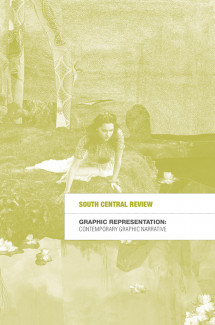
Johns Hopkins UniversityEst. 1876
America’s First Research University
Digging Into Graphic Narrative

Late in 2015, the journal South Central Review published a special issue on "Graphic Narrative." The issue featured seven essays and two book reviews on the growing field of scholarship focused on this area of publishing. Nicole Stamant, assistant professor of English at Agnes Scott College, served as guest editor and joined us for a Q&A to take a deeper look at the issue.

How did this issue come together?
NS: In 2013, the Editor of South Central Review, Joe Golsan, was visiting the Victoria and Albert Museum, in London. That year, there was a special, interactive exhibit that featured graphic narratives and it got him thinking about how the journal could engage these kinds of stories. The journal is devoted to the intersection of culture and academia, and this special issue is a great manifestation of such dedication. After this experience at the Victoria and Albert, Joe spoke to Nicholas Lawrence, the journal’s Managing Editor, who got in touch with me. Much of my research and teaching revolve around graphic narrative, and when Nick indicated that there was a desire for South Central Review to assemble a special issue on graphic narrative, I thought it was a fantastic idea.
No specific direction or subgenre was indicated for the special issue, which I thought was exciting, too. As I write in the introduction, while we have seen a real increase in overall scholarship about graphic narrative, it’s a particular thrill to have as storied a journal as South Central Review take an interest in it. Frankly, such an interest is a testament to the journal itself—they’re committed to being on the cutting edge of contemporary scholarship. Although my own research focuses on life writing and graphic memoir, I quite liked the idea of an open discussion about graphic narrative and was optimistic that we would get a real variety of analyses. We put out a general call for articles about graphic narrative and received some great submissions. I organized the issue from there, based on trends featured in the essays: an investment both in the unique potential and power of graphic narrative and in how graphic narratives foreground negotiations of representation, of structure and form, of visibility, of the archive, and of publishing itself.
In the intro, you mention that this issue takes for granted that graphic narrative scholarship is needed. How important is it that this kind of analysis is more accepted now?
NS: To be honest, it’s enormously important. We are lucky to be in a literary moment of true proliferation, in a moment in which stories are being told by people who may have had a much more difficult—or impossible—time sharing their stories at other points, and in all kinds of ways. Graphic narrative is one such form, and the fact that we are taking this form seriously, in all of its variability, allows us as readers and thinkers new ways to understand being in this world. We live in a moment saturated with the confluence of text and image, and it makes sense that our storytelling strategies would reflect such intersections. So, paying attention to graphic narrative matters generally; in scholarship, it is perhaps even more crucial to consider issues of representation and diversity of storytelling. Graphic narrative is fundamentally cross-disciplinary, negotiating text and image, and graphic narrative scholarship has the potential to help articulate what it is that makes graphic narrative so special. In addition, scholarship can influence pedagogy, and one of the hopes for this special issue is that these articles allow those who may not be steeped in Comics Studies the opportunity to learn a bit more about what is happening in contemporary graphic narrative and how these kinds of texts can be incorporated into classrooms and shared with students.
What new ground is broken by the articles in this issue?
NS: Importantly, this issue includes articles about outstanding texts that do not yet have a large scholarly presence: Sinéad Moynihan’s analysis of Mat Johnson and Warren Pleece’s Incognegro and Jim Coby’s discussion of Josh Neufeld’s A.D.: New Orleans After the Deluge do a lot of work in the service of these books and these stories. These articles substantively provide nuanced negotiations of history, experience, technology (as with Neufeld’s hyperlinked text), and literary tradition, and it is a real privilege to have had the chance to put them into print. For the contributions about texts that are more well known, the articles add complexity to the conversations: this is particularly true with Robert Hutton’s consideration of the publishing industry—he uses Art Spiegelman’s Maus as a test case for its significance in our understanding of graphic narratives—and Frederik Byrn Kohlert’s negotiation of trauma studies in Phoebe Gloeckner’s work. There are also articles that posit new theoretical foundations about graphic narrative; Nancy Pedri’s work on ocularity and focalization and K.W. Eveleth’s presentation of labyrinthine aesthetics are incredibly interesting and useful. They all work together to, I hope, present readers with a microcosm of the discussions happening elsewhere in scholarship and in classrooms, and they’ve already changed the way I understand and teach these texts.
What does the future hold for serious examination of graphic narratives?
NS: It is such a fantastic time to be reading, creating, and writing about graphic narratives! There are so many important works that academia hasn’t quite discovered, yet, or works that we haven’t given the real attention they deserve. Contemporary graphic narrative allows for untold new ways of considering experience, and continuing studies of comics and graphic narrative should demand close attention to issues of (re)presentation more generally. I hope that we will continue to recover comics and graphic narratives that are buried in the archives; that the myriad forms and modes of graphic narratives challenge our assumptions about lived realities and imagined worlds; and that there continues to be the kind of rigorous, careful consideration about graphic narrative that we’ve seen in the last decade.


